Note 44
Financial risk management
With respect to financial risks, the Group observes a uniform funding policy that has been approved by the company Board of Directors. Compliance with this policy and developments in the Group's financial situation are monitored by the Board of Directors' Audit Committee. The Group's Treasury is centrally responsible for the Group funding, liquidity management, relations with providers of finance, and the management of financial risks. In the main, the Group's funding is arranged through the parent company, and the Group's Treasury arranges intra- Group loans for the funding of subsidiaries in their functional currencies. For companies with significant external ownership, the Group has not guaranteed financial liabilities in excess of its ownership interest.
Currency risk and sensitivity analysis
The Group's balance sheet is exposed to translation risks in
connection with investments in subsidiaries outside the euro
area. This balance sheet exposure has been hedged by using
currency-denominated loans and forward rate agreements if
the translation risk is in excess of €1 million. The most significant
balance sheet exposure positions are in Estonian kroon,
Norwegian krone, Swedish krona, Russian ruble, Lithuanian lit
and Latvian lat.
The Group has not hedged foreign-currency-denominated
goodwill (incl. allocated goodwill), whose countervalue was
€55.5 million (€112.4 million) at 31 December 2008.
The currency risk exposed to translation risk, excluding foreign-
currency-denominated goodwill, is small in proportion to
the volume of operations and the balance sheet total. A simultaneous
20% weakening of the six central currencies (NOK, EEK,
LTL, RUB, LVL, SEK) against the euro would result in a €5.6 million
(€9.1 million) negative change in equity at 31 December
2008.
The euro has been adopted as the functional currency of the
real estate companies in St. Petersburg and Moscow in Russia, which is why no significant exchange differences are realised
from their balance sheets for the Group.
Kesko Corporation's USD-denominated private placement loan
has been hedged against currency risk and interest rate risk
applying hedge accounting. Currency and interest rate swaps in
the same amount and maturity as the loan have been designated
as the hedging instruments. Consequently, the loan is
entirely hedged against currency and interest rate risk. During
the period, no amount of ineffectiveness has been recognised in
the income statement relating to this credit facility.
International purchasing activity exposes the Group to transaction
risks relating to several foreign currencies. The subsidiaries
report their foreign currency positions to the Group's Treasury,
in other words, the currency risk is monitored at the Group
level on a monthly basis. The risk can be managed by using currency
derivative instruments to hedge open positions, by modifying
selling prices, or by changing suppliers. The percentage of
hedging is decided separately by each relevant subsidiary and
business unit. Transaction risk exposures mainly concern the US
dollar. The subsidiaries carry out their hedging operations
together with the Group's Treasury, which hedges risk positions
using market transactions within the limits confirmed for each
currency. Intra-Group derivatives have been allocated to segments
in segment reporting.
48% of foreign currencies bought for commercial purchases
are USD-denominated, which makes other currencies insignificant
with regard to sensitivity analysis. A sensitivity analysis
for the currency risk relating to the USD would have contributed
a pre-tax profit of €+/-1.0 million (€+/-0.4 million) at the balance
sheet date of 31 December 2008, had the USD rate change
been +/-10%. It is assumed that the other variables remain
unchanged. The calculation includes foreign currency denominated
trade payables, trade receivables and currency derivatives
recognised in the balance sheet. Their combined net position
totals €15.1 million (€6.4 million). The analysis does not consider
the foreign currency denominated orders, some of which are
also hedged.

The Group's foreign subsidiaries also buy currency independently
for commercial purchases. Such purchases do not, however,
constitute a significant part of total purchases.
The Group does not apply hedge accounting in accordance
with IAS 39 to hedging commercial currency risks. In initial
recognition, derivative instruments are recorded at cost and
at subsequent measurement they are recognised at fair value.
Value changes of currency derivatives used to hedge purchases
and sales are recognised in other operating income or expenses.
The Group companies' financing is arranged in their functional
currencies, which means that the parent company bears
the currency risk relating to financing and hedges the exposure
using derivatives or foreign-currency-denominated loans. Most
of the currency position has been hedged and during the 2008
financial period, the cost of hedge arising from them and equity
hedging was €4.6 million. The hedging cost is the interest rate
difference between the euro and the currency being hedged.
These interest rate differences increased sharply towards the
end of 2008.
Loan interest rate risk and sensitivity analysis
Changes in interest rate level affect the Group's interest
expenses. The interest rate level correlates negatively with private
consumer demand and investment demand, which is why
financial results in a rising interest rate environment are
affected by higher interest expenses, while the demand for
products and services slackens. Interest rate hedging is used to
equalise the effects of interest rate movements on the profits
for different financial periods.
Interest rate risks are centrally managed by the Group's Treasury,
which adjusts loan duration using interest rate derivative
instruments. The target duration is three years and it is allowed
to vary between one and a half and four years. The realised
duration during the period was 3.2 (3.0) years on average.
A sensitivity analysis for commercial paper liabilities realised
during the period uses average balance values. At the balance
sheet date of 31 December 2008, the interest-bearing variable
rate liabilities and interest rate derivative instruments hedging
loans from financial institutions would have contributed
€-/+3.8 million to the pre-tax profit, had the interest rate level
risen or fallen by 1 percentage point (€-/+4.6 million).
Liabilities to K-retailers consist of two types of interest-bearing
receivables payable by the Kesko Group companies to
K-retailers: retailers' prepayments to Kesko, and retailers' chain
rebates. Chain rebates are subsequent discounts granted to
retailers and their terms vary from one store chain to another.
Private placement bonds and the amount of €120.5 million of
loans from financial institutions have fixed rates and the effective
interest cost is 5.3%. At the end of period, the average rate
of loans from financial institutions with variable interest rates,
liabilities to retailers and other interest-bearing liabilities was
5.5%. Some of the loans are euro-denominated, private placement
bonds are USD-denominated, and loans from financial
institutions and commercial paper liabilities include NOKdenominated
loans corresponding to €20.5 million (€25.1 million),
EEK-denominated loans corresponding to €17.9 million
(€26.0 million), LVL-denominated loans corresponding to €29.8
million (€47.6 million) and LTL-denominated loans corresponding
to €0 million (€24.4 million).
Liquidity risk and sensitivity analysis for interest-bearing receivables
Liquidity risk management aims at maintaining sufficient liquid
assets and credit lines in order to guarantee the availability of
sufficient funding for the Group's business activities at all
times.
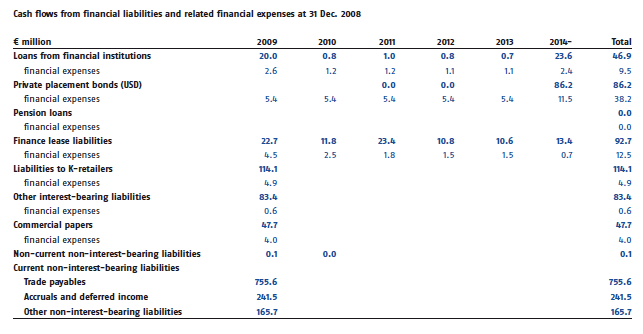
The aim is to invest liquidity consisting of cash and cash
equivalents in the money market by using efficient combinations of return and risk. At regular intervals, the Group's management
approves the instruments and limits for each investment
among those analysed by the Group's Treasury. The risks
and actual returns of investments are monitored regularly.
The Group's liquid assets have mainly been invested in debt
instruments of major Finnish companies, in certificates of
deposit and deposits in banks operating in Kesko's market area,
and in Finnish government bonds. At 31 December 2008, investments
in commercial papers totalled €203.4 million (€176.6 million),
in bank certificates of deposit and deposits €140.9 million
(€17.5 million), in bond funds €9.4 million (€66.9 million) and in
Finnish government bonds €31.7 million (-). For 2008, the return
on these investments was 4.9%. The maximum credit risk is the
above fair value of these investments in the balance sheet at
the balance sheet date.
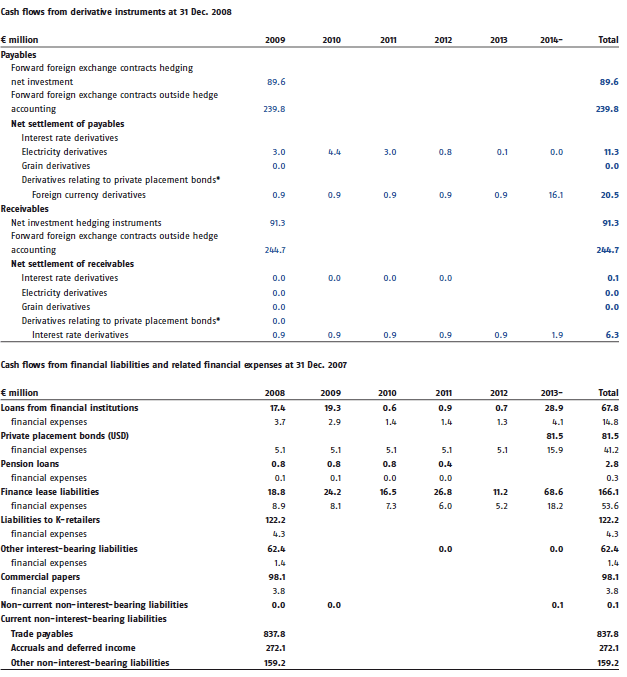
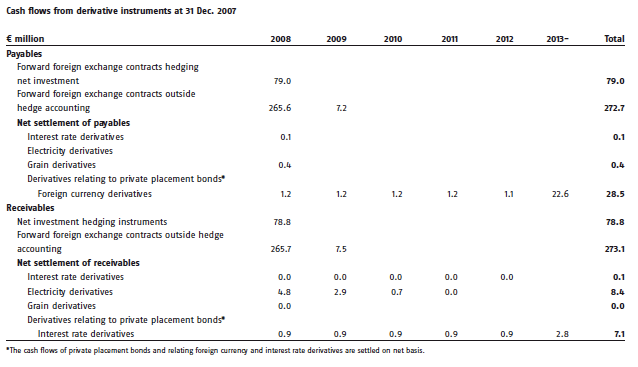
A sensitivity analysis for variable rate receivables uses average
annual balance values of invested assets. The receivables
include customer financing receivables, finance lease receivables,
other interest-bearing receivables, and investments in
commercial papers and bond funds. The sensitivity of bond
funds has been determined based on duration. These items
would have contributed €+/-4.4 million (€+/-4.4 million) to the
pre-tax profit at the balance sheet date, had the interest rate
level changed by +/-1 percentage point.
At the balance sheet date, the counter value of undrawn
committed long-term credit facilities was €247 million (€225
million). The committed credit limits mature at the end of 2010,
2011 and 2012 and are expected to be renegotiable. In addition,
the Group's euro-denominated uncommitted credit lines available
contain commercial paper programmes denominated in
Estonian kroon, Lithuanian lit and Latvian lat to a total counter
value of €449 million (€541.7 million).
The terms and conditions of the private placement credit
facility and the committed limit include financial covenants. The
requirements of these covenants have been met.
Credit risk
The business companies of the Group's divisions are responsible
for the credit risk related to receivables from customers. The
company has a credit policy and compliance with it is monitored.
Receivables are secured by carefully assessing customers'
creditworthiness, by reviewing customer credit terms and collateral
requirements, by effective credit control and credit
insurances as applicable. In Finland, the main part of the
Group's business activities is carried out in cooperation with
retailers. According to the retailer agreements, retailers lodge
bank overdrafts as collateral against their trade payables to the
relevant Kesko subsidiaries.
Group companies apply a uniform practice to measuring overdue
receivables. A receivable is written down when there is
objective evidence of impairment.
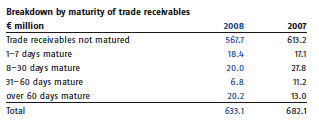
Of trade receivables, €298.1 million (€276.9 million) were from
chain retailers and €21.4 million (€27.4 million) were credit card
receivables. The collateral for chain retailer receivables is an
overdraft facility granted by a Kesko associate, Vähittäiskaupan
Takaus Oy, with the maximum always limited to the realisation
value of the counter collateral given by the K-retail company
and entrepreneur to Vähittäiskaupan Takaus. At the end of
period, the total value of the counterparty collateral was €164.5
million. In addition, the collateral for receivables includes other
collateral, such as business mortgages and other pledged
assets.
The amount of trade receivables with renegotiated terms
included in financial assets is insignificant.
Financial credit risk
Financial instruments involve the risk of counterparties failing to settle their obligations. Kesko only makes currency and interest rate derivative contracts with banks that have good creditworthiness. Liquid funds are invested annually, within the limits confirmed for each counterparty, in instruments with good creditworthiness.
Borrowing agreements at change of control (over 50% interest)
According to the terms of Kesko Corporation's USD-denominated
private placement loan, in a situation involving a change of
control, Kesko is obligated to offer a repayment of the whole
loan capital to all noteholders. The noteholders have the right
to accept or refuse the repayment.
According to the terms of Kesko Corporation's syndicated loan,
the syndicate has the right to call in the loan and any withdrawn
loan amounts.
According to the terms of either loan agreement, a transfer of
ownership to retailers or a retailers' association shall not be
considered a change of control.
Credit ratings
For the present, Kesko Corporation has not applied for a credit rating, because it has not been considered necessary in the company's present financial situation.
Commodity risks and their sensitivity analysis
The Group uses electricity derivatives to level out energy costs.
The electricity price risk is evaluated for five-year periods. The
value changes of derivatives hedging the price of electricity
supplied during the period are included in the adjustment
items of purchases. Hedge accounting is applied to contracts
hedging future purchases. The effective portion of derivatives
that meet hedge accounting criteria are recognised in the
revaluation reserve of equity and the ineffective portion in the
income statement in other operating income or expenses.
At the end of the year, the ineffective portion was €-0.9
million.
At the balance sheet date, a total quantity of 1,174,056 MWH
(853,044 MWH) of electricity had been purchased with electricity
derivatives and the 1–12 month hedging rate was 75.4% (75.8%),
the 13–24 month rate 62.3% (47.2%), the 25–36 month rate
34.1% (20.2%), the 37–48 month rate 12.6% (-) and the 49–60
month rate 9.6% (-).
A sensitivity analysis for electricity derivatives assumes that
derivatives maturing within less than 12 months have an impact
on profit. If the market price of electricity derivatives changed
by +/-20 percentage points from the balance sheet date 31
December 2008, it would contribute €+/-3.5 million (€(+/-3.1
million) to the 2009 profit and €+/-5.3 million (€+/-3.8 million)
to equity. The impact has been calculated before tax.
The Group's agricultural division uses an insignificant amount
of grain derivatives to hedge against grain price risk.
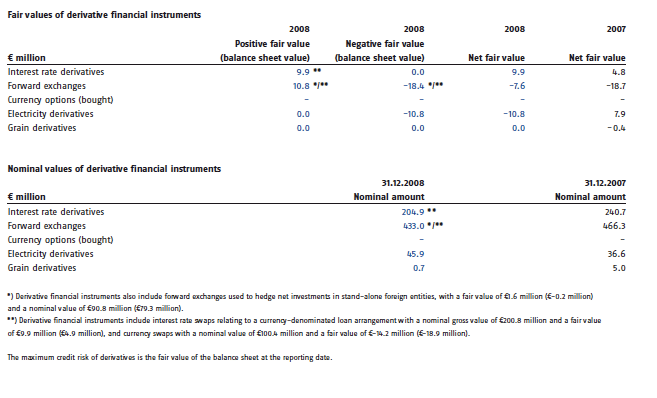
Capital structure management
Due to the global financial crisis and the consequent weakening
of the real economy, the importance of capital structure
management was increasingly emphasized in 2008. The Kesko
Group's capital management objectives include targets set for
the Group's solvency and liquidity, as well as its capital
productivity.
The objectives for the Group's solvency and liquidity are set
with the purpose of securing the Group's liquidity in all market situations, enabling the implementation of investment programmes
based on the Group's strategy and maintaining the
shareholder value. Objectives have been set to equity ratio and
interest-bearing net debt/EBITDA. The calculation formulas for
these indicators are presented in the financial statements, on
page 133. The Group's interest-bearing debt include covenants,
whose terms and conditions have been taken into account in
the above target levels. The Group does not have a credit rating
given by any external credit rating institution.
The purpose of setting objectives for the Group's capital productivity
is to steer the operating activities in increasing shareholder
value on a long-term basis. The objectives of capital productivity
excluding non-recurring items have been set to the
Group's equity and capital employed. The calculation formulas
for the indicators 'return on equity' and 'return on capital
employed' are presented in the financial statements, p. 133. The
Group's capital structure (equity-to-debt ratio) is only optimised
at the Group level, which is why at the lower levels of divisions
and companies, the targets relating to the productivity of capital
have been set to the indicators 'economic value added' and
'return on capital employed'.
Economic value added formula:
Operating profit excluding non-recurring items
- operational taxes
- return requirement for average capital employed
+/- other adjustment items
The above target levels set for the Group's financial indicators
are submitted for approval by the Board of Directors. On 4 February
2009, the Board approved the following values for the
Group's medium term objectives.
